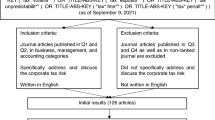Abstract
Alternative risk premium (ARP) has experienced significant growth as an investment category in recent years. While considerable educational efforts accompanied this growth, gaps and misunderstandings persist. This paper provides a detailed definition of and contextualization of ARP as well as a comprehensive review of its academic roots, explaining that ARP sits at the confluence of decades of research on empirical anomalies, hedge fund replication, multi-factor models and data snooping.





taken from Hedge Fund Research, Inc. (HFR). The bullets list the typical underlying approaches. (Note that these are not the HFR sub-strategy descriptions.)

Similar content being viewed by others
Notes
These friction-related dynamics that may explain the gap between finance theory and empirical findings are summarized in Table I.1 in Pedersen (2015): Modigliani-Miller irrelevance of capital structure vs. capital structure matters; two fund separation where all investors invest in the market portfolio and cash vs investor select different portfolios depending on their individual funding constraints; capital asset pricing model versus the influence of liquidity risk and funding constraints on expected returns; law of one price and Black-Scholes framework for pricing derivatives vs arbitrage opportunities impact derivatives pricing; Merton’s rule on exercising a call option vs optimal early and conversion; real business cycles and Ricardian equivalence regarding the irrelevance of macroeconomic policy on finance vs credit cycles and liquidity spirals that drive the interaction of macroeconomic policy, asset pricing, and funding constraints; and Taylor’s rule regarding monetary authorities impact on interest rates vs two monetary tools impact on interest rates and collateral polity.
Note that a few of the constituents in Table 1 arguably could reside in a different column—primarily the event driven strategies. Convertible bond arbitrage is one example. Because the strategy typically assumes some mispricing in the convertible bond, this table classifies convertible arbitrage as convergence. But there are many possible convertible arbitrage trades involving various hedges of delta, rho, vega, gamma, and credit, some of which might support slotting the trade under carry instead of convergence. Share buyback is another example having attributes of quality (balance sheet integrity) and relative value (long positions in negative net issuance companies coupled with negative positions in diluting companies). With few exceptions, however, strategy placement (Table 1) is intuitive.
References
Ang, A., W. Goetzmann, and S. Schaefer. 2009. Evaluation of Active Management of the Norwegian Government Pension Fund—Global. Working paper.
Barras, L., O. Scaillet, and R. Wermers. 2010. False Discoveries in Mutual Fund Performance: Measuring Luck in Estimated Alphas. Journal of Finance 65 (1): 179–216.
Carhart, M. 1997. On Persistence in Mutual Fund Performance. Journal of Finance 52 (1): 57–82.
Charoenrook, A. and J. Conrad. 2008. Identifying Risk-Based Factors. Working paper.
Chronert, S. and L. Odette. 2016. ETF Perspectives: A Look at Hedge Fund Replication ETFs. Citi Equities Research.
Fama, E., and K. French. 2010. Luck Versus Skill in the Cross-Section of Mutual Fund Returns. Journal of Finance 65 (5): 1915–1947.
Ferson, W. and Y. Chen. 2015. How Many Good and Bad Fund Managers Are There, Really? Working paper.
Ibbotson, R., P. Chen, and K. Zhu. 2011. The ABCs of Hedge Funds: Alphas, Betas, and Costs. Financial Analysts Journal 67 (1): 15–25.
Jenkins, I., A. Morris, S. Lee, and A. Murakami. 2013. Alternative Beta: A Primer. Nomura Equity Research, Global Quantitative Strategy.
Kolanovic, M., and Z. Wei. 2013. Systematic Strategies across Asset Classes: Risk Factor Approach to Investing and Portfolio Management. New York: J.P.Morgan.
Kolanovic, M., and Z. Wei. 2014. Equity Risk Premia Strategies: Risk Factor Approach to Portfolio Management. New York: J.P.Morgan.
Kolanovic, M., and Z. Wei. 2015. Momentum Strategies across Asset Classes: Risk Factor Approach to Trend Following. New York: J.P.Morgan.
Lempérière, Y., C. Deremble, T.T. Nguyen, P. Seager, M. Potters, and J.P. Bouchaud. 2014. Risk Premia: Asymmetric Tail Risks and Excess Returns. Quantitative Finance 17: 1–25.
Little, P. and G. King. 2012. Investable Indexed Approaches to Long/Short Investing: Factor- and Mechanical-Based Replication Methods. Journal of Indexes, 22–27.
Mesomeris, S., Y. Wang, M. Salvini, and J. Avettand-Fenoel. 2012. A New Asset Allocation Paradigm. Deutsche Bank Quantitative Strategy Europe.
Pedersen, Lasse H. 2015. Efficiently Inefficient: How Smart Money Invests and Market Prices are Determined. Princeton, NJ: Princeton University Press.
Rennison, G. and A. Staal. 2010. Alternative Investment Allocations: The Role of Investable Indices. Barclays Capital Systematic Strategies.
Tien, D., L. Wang, and C. Hsu. 2010. Thematic Index Strategies as Building Blocks for Thematic Portfolios. Credit Suisse Systematic Alpha Monthly.
Turc, J., R. Dando, S. Ungari, T. Kovarcik, S. Ramegowda, D. Tzotchev, L. Ravagli, and F. Gu. 2016. Risk-Premia Strategies: Applying a Risk Premia Strategy in Asia Pacific also Makes Sense. Societe Generale Cross Asset Quant Research.
Turc, J., S. Ungari, A. Lapthorne, G. Oikonomou, V. Cassot, and A. Boukhari. 2013. Risk-Premia Strategies: A Way To Distance Yourself from the Crowd. Societe Generale Global Quantitative Research.
Author information
Authors and Affiliations
Corresponding author
Additional information
Publisher's Note
Springer Nature remains neutral with regard to jurisdictional claims in published maps and institutional affiliations.
Rights and permissions
About this article
Cite this article
Gorman, S.A., Fabozzi, F.J. The ABC’s of the ARP: understanding alternative risk premium. J Asset Manag 22, 391–404 (2021). https://doi.org/10.1057/s41260-021-00231-3
Revised:
Accepted:
Published:
Issue Date:
DOI: https://doi.org/10.1057/s41260-021-00231-3




